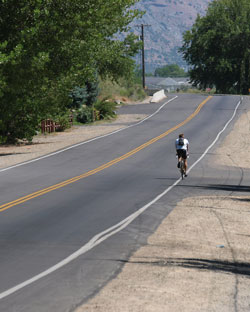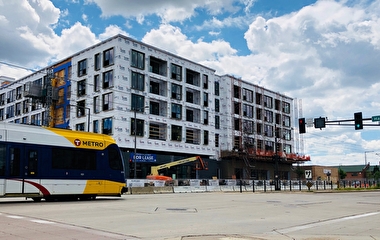Across Minnesota, local agencies need better information about where and how many people are biking and walking to make decisions about infrastructure investments, understand safety risks, and even plan active living initiatives.
To help provide agencies with bicycle and pedestrian traffic data, U of M researchers have been working with the Minnesota Department of Transportation (MnDOT) on the Minnesota Bicycle and Pedestrian Counting Initiative since 2010. The initiative is a collaborative, statewide effort to support bike and pedestrian traffic monitoring by local, regional, and state organizations.
Recently, the project team completed an implementation study—the second of three MnDOT-funded projects related to the initiative—specifically designed to engage local agencies. The goal was to demonstrate the feasibility of using both permanent and portable sensors to collect bicycle and pedestrian traffic data in several Minnesota cities, suburbs, and small towns.
“If we want to institutionalize counting and monitoring across the state, local agencies need to know it’s not something that’s only important for large cities like Minneapolis,” says principal investigator Greg Lindsey, professor at the Humphrey School of Public Affairs and current MnDOT scholar-in-residence. “We have to be on the ground in these places, illustrating that it’s relevant to the decisions they’re making.”
To that end, the team worked with agencies in Duluth, Eagan, Minneapolis, Bemidji, Grand Marais, Rochester, and Hennepin County during the implementation study. In these locations, the team installed commercially available sensors—including inductive loops, passive infrared, pneumatic tubes, and radio beams—to collect traffic counts. Overall findings indicate that all of the sensors produced reasonably accurate measurements—and that participating agencies found value in the collected data.
In Grand Marais, for example, the team collaborated with staff from the Sawtooth Mountain Clinic Moving Matters program and MnDOT District 1 to complete short-term counts around the city. The data were then used as part of the health impact assessment for a proposed Highway 61 corridor redesign project. The project, which aims to improve safety, access, and the economics and livability of the community, includes alternatives to improve bicycle and pedestrian infrastructure.
In Minneapolis, the research team demonstrated how traffic counts can be used to develop measures of average annual daily traffic (AADT)—a commonly used performance measure in transportation planning. The team used data from both permanent and short-term counters on the 80-mile Minneapolis trail network to estimate AADT for each trail segment. Researchers then estimated total miles traveled by cyclists on the entire trail network.
Findings and case studies from the study have already been incorporated into the draft Bicycle and Pedestrian Data Collection Manual, a new MnDOT guidance document being used in statewide training workshops. Also as a result of the study, MnDOT plans to include commitments to bike and pedestrian traffic monitoring in its forthcoming statewide bicycle and pedestrian plans. In addition, MnDOT is investing in a network of permanent traffic monitoring sites around the state as well as in portable equipment that will be available to local agencies.
“Integrating our efforts with local agencies is a powerful thing for us as we build an integrated, comprehensive transportation plan for Minnesota,” says MnDOT commissioner Charles Zelle. “The data can help show decision makers that people are using the vibrant bike and pedestrian system across our state. It can also show our partners that [the system] is very much a part of our statewide economy, quality of life, and health.”





